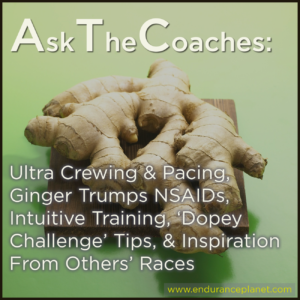ATC: Ultra Crewing and Pacing, Ginger Trumps NSAIDs, Intuitive Training, ‘Dopey Challenge’ Tips, and Inspiration From Others’ Races
July 25, 2015 In this episode, our coaches (Tawnee and Lucho) cover a ton of questions and topics… including:
In this episode, our coaches (Tawnee and Lucho) cover a ton of questions and topics… including:
-Tips for crewing an ultra (like tawnee will be doing at Badwater 135).
-How to survive all-nighters when in real life you love sleep, how to fuel, how to maintain good energy for your runner, how to manage the weather extremes (HEAT!), etc.
Links to check out:
-Blogs from Lucho’s pacer Tim Long.
–New research on ginger in the Journal of Strength of Conditioning.
Listener Questions:
Peter W.
First off, thanks for all the great content week to week. You all make the traveling I do for work and the training I do indoors much more bearable. Keep it up! Now, I’m going to sign up for Ironman Lake Placid this coming week and even though I have a long way to go until next year’s training even begins, I am thinking about trying a new training style. I have done IMLP twice (2011 and 2014) with good results. However, I was flogging myself to get them. I use a typical 24 week training schedule that is fine in the beginning, but when the volume gets up too high, I become a zombie. It wears on me emotionally and takes a while to dig myself out of the hole I put myself in. That being said, my results have been good, so it becomes a struggle of do the ends justify the means… This year I want to take the Ben Greenfield approach, but I want to know if it’s possible to achieve the same or better results without being Ben. I’ve always done lots of volume with low intensity (LOTS of zone 2, which does line up with my MAF). What if I switch my 5 hour weekend rides to 2.5-3 hours with lots of threshold work? What if I quit logging 2-3 hour long runs every Sunday and do descending 3x5k repeats? I’m pretty resilient in terms of durability. I am very results driven (even though I know at least Tawnee will tell me to give that up). I earned a Kona slot in 2014 but had to pass on it because of a family wedding already planned for October 11. I really want to get to the Big Island, so do I go to the same well again or do I roll the dice with something new?
Jonathon C.
I am running the NYC Marathon in November and the Walt Disney World Dopey Challenge in January. The Walt Disney World Dopey Challenge consists of a 5k on the Thursday of race week, a 10k on Friday, a half marathon on Saturday, and a full on Sunday. I plan on running 90% of the NYC Marathon at MAF; the 5k, 10k, and half marathon 100% MAF, and the full Marathon 80% and then see how I feel from there. I plan to be very conservative during my training, but to leave everything on the race course during the second half of the Marathon. Should I anticipate exhaustion levels to be so high during the WDW Marathon/final parts of the Marathon that I will need to train my anaerobic system? I plan on training the 8 weeks between race events exclusively at MAF, but will it behoove me to train my anaerobic system? Will I have to increase my carb consumption between WDW Dopey Challenge races? Do you have any general suggestions on timing of fueling during and between races? I usually do not consume anything during runs that are below 2hrs (I generally do not consume anything during half marathons and below). Are there any benefits/reasons to fuel during the shorter races?
Ben F.
I am a moderately experienced endurance athlete (mostly trail running and bicycle commuting these days). I do not race very often, but I enjoy other, more personal endurance adventure “projects”. In the next year or two, I am planning what I call human powered adventures (or human powered ascents). The idea is simple: avoid any kind of motorized transportation. For example, I will ride my bike about 50 miles from my house to the foot of Mount LeConte (in the Great Smoky Mountains National Park), run to the top of the mountain (4000 to 5000 feet over 6-10 miles, depending on the route), take a selfie and have snack, run back down, and ride home. This might take anywhere from 9 to 12 hours or more, depending on my fitness, weather, etc. So, I expect to be riding home in an exhausted state, possibly in the dark. What can you suggest about anticipating and minimizing the risks inherent in bicycling on the road after a long, tiring day?
One Comment
I am once again loving listening to you two!!! I had sent u a Facebook friend request and was nervously considering asking you and maybe Lucho to pace/crew me for a 100 or 200… Namely cause you two seem like the coolest people around!!! Unfortunately, I have developed a lung infection and been ill so have tossed out the idea of trying to race… Plus you never friended me :(. You and John will be awesome for Michelle. Enjoy and good luck!